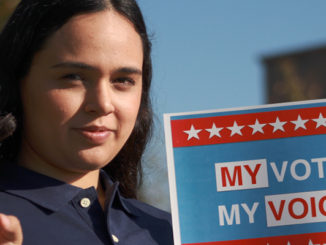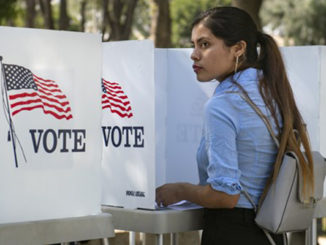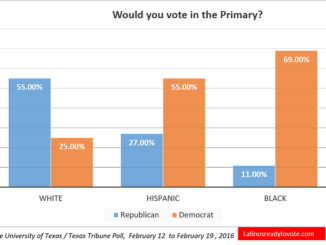
By Alex Gonzalez
This week the issue of re-districting continues to be a hot topic in the minds of Texans and Latinos. On Friday, the Federal Court in San Antonio issued an order directing the parties to keep negotiating. The order said it was the “Court’s desire to have redistricting plans in place for an April primary,” but said that “all parties must continue their negotiations to assist the Court in accomplishing this.
 From my perspective, which is evident if one compares Texas with Florida, the real issue for the Republican Party is how to keep Mexican-Americans in Texas from becoming a single district because they may vote Democrat. This is not that Republicans are a racist or a prejudicial Party, but it is just politics. In fact, Republicans likes Latinos, too. For example, in Texas the GOP is trying to stop Mexicans-Americans from becoming too solidified in a voting district, Whereas in Florida the Republican controlled legislature (in Tallahassee) is drawing districts to guarantee that those districts continue to be controlled by a single-majority Republican Cuban bloc.
From my perspective, which is evident if one compares Texas with Florida, the real issue for the Republican Party is how to keep Mexican-Americans in Texas from becoming a single district because they may vote Democrat. This is not that Republicans are a racist or a prejudicial Party, but it is just politics. In fact, Republicans likes Latinos, too. For example, in Texas the GOP is trying to stop Mexicans-Americans from becoming too solidified in a voting district, Whereas in Florida the Republican controlled legislature (in Tallahassee) is drawing districts to guarantee that those districts continue to be controlled by a single-majority Republican Cuban bloc.
In Florida, new non-Cuban residents in a 3 Cuban-majority congressional district are now registering as independents and Democrats. However, the Republican Legislature in Tallahassee approved a redistricting plan that would offer safer and stronger districts for Miami’s three Cuban-American Republican lawmakers, U.S. Reps. Mario Diaz-Balart, Ileana Ros-Lehtinen and David Rivera. According to the Miami Herald, in the district represented by Ileana Ros-Lehtinen, “61 percent of the newcomers registered as no party affiliation; 26 percent registered as Democrat; and, Republican registration dropped 3 percent.” So it is in the best interest of Republican Party in Florida to keep Cuban-majority districts by drawing lines where they can split the new non-Cuban independent registered voters; thus, in this political arrangement “Old” Cubans voters will continue to vote Republican in south Florida because they trade-off votes with the Republican Party to have their districts “safe” for Tallahassee and for Congress. It is legal, if you can get away with it, and not considered racist because that is how the game of politics is played.
As expected, a coalition of voting groups challenged the proposed political boundaries, The Florida League of Women Voters and the National Council of La Raza, claim that the new boundaries will “undermine the voter’s will.” In one of old district belonging to David Rivera most of the new voters — 42% — registered as independent or no party affiliation. Meanwhile, 36% registered as Democrat and 20% registered as Republican. Consequently, it makes sense, politically speaking, to want to split the new independents and democrats and put them in districts where Cubans will still have majority. In Florida, “Cuban super voters, “older Cuban Americans who are passionate about getting their like-minded representatives in office,’’ who turn out reliably and vote consistently for Cubans. Democrats have a 2-1 registration advantage over Republicans in Miami-Dade, but Cuban super voters have “helped Republicans dominate in local, state and federal elections.
Now, if this arrangement works between “Hispanics” and the GOP in Florida, why wouldn’t the Republican Party of Texas want to create and protect Mexican districts the same way they protect Cuban Districts? The answers is the Republican Party of Texas is suspicious that Mexican districts will not vote Republican, and therefore, opts to push for districts to split the Mexican voters and keep majority “old “white-majority voting bloc.
For example, the best argument Republicans made in defense of splitting the Mexican Vote in Texas is by state Rep. John Garza. Rep. Garza’s argument, is that ethnicity equal voter pattern is “only a myth” because the Hispanic vote in Texas is not cohesive. “Hispanics, like all Americans, are not a politically cohesive group and hold a plurality of political beliefs.” Garza’s argument is straight forward: Latinos don’t always vote the same way, and thus, the argument for single-ethnicity district is unnecessary because they Hispanic won’t vote for one of their own, as the Civil Rights Act of 1966 presumes. But, if this was the case and ethnicity is not a predictor for voting among Hispanics, why do Republicans in Florida want to keep all Cubans as the majority in 3 congressional districts?
In an answer to this dilemma my colleague , Linda Vega, wrote an article arguing that:
areas in the U.S. that were more prone to discrimination were targeted by this act, namely southern states. When the law was first challenged in 1986, the Supreme Court in Thornburg v. Gingles, established a three-part test to single-member districts should they be created. First, the minority group should be sufficiently large and geographically compact to constitute a majority in a single-member district. Second, the minority group should vote as a cohesive bloc. Finally, the majority group cannot vote so as to defeat the minority group’s preferred candidate. {NOTE: Minority is in number not race} This interpretation, by the Supreme Court of the Voting Rights Act should have given the idea to Republicans in Texas how crucial it was to keep Hispanics in single-member-minority district since Hispanics are a social conservative bloc.
Furthermore, Section 5 of the Act delineates the U.S. Attorney General or the Department of Justice or a U.S. District Court to determine if any change would be discriminatory in purpose or effect. A change is when redistricting lines or rules are proposed to determine voting eligibility. If a change may appear to be controversial, Federal Examiners and Federal Pollsters could monitor so as to ensure that the “changes” were fair under the law. In the 1970’s as the U.S. population was gaining ground with Latinos, Asians, and other groups, this section was extended to apply throughout the United States, namely in the Southwestern area of the United States.
In her understanding of the law, Linda Vega, an Immigration attorney, argues that the Republican Party in Texas would do a better job keeping Latinos—Mexicans- districts unified as single-bloc because Latinos are naturally social conservatives, and thus, fertile ground for the GOP. In fact, Ms. Vega argues, that the GOP needs to work on outreach campaigns for Latinos rather than drawing districts where Hispanics are split and pushed into anlgo-majoroty districts. Moreover, this is a detriment because this conveys the idea that Republicans are working against the interests of the Latinos community. And she is right.
 Moreover, in Texas, 52% of Latinos self-identify as conservatives. Therefore, ethnicity in fact, may lead to voter pattern among Hispanics; not so much because they are monolithic as a group, but because all Latinos in Texas care about the same pressing issues: jobs, education and immigration. This then, is indeed a cohesive voice.
Moreover, in Texas, 52% of Latinos self-identify as conservatives. Therefore, ethnicity in fact, may lead to voter pattern among Hispanics; not so much because they are monolithic as a group, but because all Latinos in Texas care about the same pressing issues: jobs, education and immigration. This then, is indeed a cohesive voice.
By looking to re-districting in Florida and the Op-Ed by Rep. Garza, we can see that re-districting is more about state politics than legality or representative democracy. Mr. Garza’s argument could not work in Florida because the GOP is drawing lines based on an ethnic Hispanic voting pattern that leads to Republican victories. Conversely, Ms. Vega’s legal and community outreach argument will not make Republican legislators happy because they need to have guarantees that they will keep the majority.
Therefore, in Texas we are presented with a circular argument, or redundant question, of who is going to give in first. Is the Republican GOP going to give Mexican-Americans their own district in hope that they will vote Republicans? Or are the Mexican-Americans going to vote Republican so the state GOP can agree to give them a single-majority Mexican district. We are playing the game of Chicken with this important vote, let’s see who will blink first.



